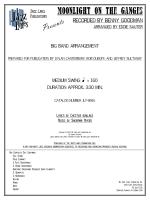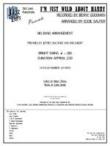MOONLIGHT ON THE GANGES
Recorded by the Benny Goodman Orchestra
Arranged by Eddie Sauter, Prepared for Publication by Dylan Canterbury, Rob DuBoff, and Jeffrey Sultanof

Cat #: JLP-8916
$65.00This item usually ships within 1 business day.
Questions?
Please call +1-518-587-1102 or email us.
Edition: Jazz Big Band Arrangement
Description: Swing - Medium Difficult
Publisher: Jazz Lines Publications
Eddie Sauter's dance band arrangements for Benny Goodman still stand up as some of the finest, most creative works the legendary clarinetist ever put out. Even still, his arrangement of Moonlight on the Ganges finds a way to stand out from the crowd due to its highly unique treatment of an already unique standard.
Beginning with an ominously ascending figure in the piano atop a bass clarinet ostinato, the melody comes in at measure 5, handled by muted trumpets with a mildly dissonant counter line in the saxophones. The initial melody statement continues to stay mostly in the brass, while the saxes largely stick to a complimentary role. Things become surprisingly dramatic at measure 35, however, when the brass play a rhythmically stop-start ascending line that gradually increases in volume until climaxing at measure 41.
The brass proceed to tail off while the saxes play a decidedly off-key riff to set up a key change for a chorus of Goodman's clarinet. The backgrounds here are surprisingly intricate, and will require your ensemble to strike a balance to achieve proper support for the soloist without becoming overwhelming. Following Goodman is a brief ensemble fanfare that sets up another key change, this time for a half chorus trumpet solo beginning at measure 79. The backgrounds here fall more into traditional big band riff-based fare. Goodman's clarinet gets another brief interjection before the sax section gets a short soli for the form's final 8 measures at measure 103.
Yet another key change at measure 111 announces the arrangement's final melody statement. The shouting ensemble trades off every 8 measures with Goodman's clarinet, but the energy level should remain consistent regardless of what part of the band is carrying the tune. Rather than opting for a traditional tagged ending, Sauter goes for a more unorthodox conclusion featuring roaring brass atop a rapidly descending saxophone figure. Starting out mildly dissonant, the harmony pleasantly resolves just in time for the grand finale.
The majority of this arrangement has been prepared from the original parts from Benny Goodman's library. Unfortunately, the entire 3rd woodwind part and a portion of the 5th woodwind part have been lost over the years. They have been transcribed from the original recording accordingly.
Solo Clarinet
2 Alto Saxophones
2 Tenor Saxophones
Baritone Saxophone (Doubles Bass Clarinet)
3 Trumpets
2 Trombones
Guitar
Piano
Bass
Drums
Trombone 1 and 2: Bb4








![FOCUS [SCORE] View: FOCUS [SCORE]](https://www.ejazzlines.com/wp-images/product/thumbnail/jlp-8900.jpg)

